

At Gatekeeper, we put Kanban at the heart of our Workflow Engine to help our customers better manage their contracts and vendors. A contract management workflow helps customers to identify bottlenecks, drive action and stay one step ahead.
However, the more we talk to customers and prospective customers, the more we realise that Kanban is a concept that’s not always widely recognised or understood.
Therefore, the aim of this article is to provide some background on the principles of Kanban and then to demonstrate exactly how it can help optimise the management of contracts and suppliers through time and effort saved and the reduction of errors.
So, first things first...
Put simply, Kanban is a system for visualising work, so that it can be monitored accurately and improved over time.
Kanban is a Japanese word that literally translates as “visual signal” or "visual board".
It was originally implemented in Toyota during the 1940s to help them optimise their engineering processes, and was much later refined by David Anderson (2004), a software consultant at Microsoft, to apply to modern software development.
However, it now sits at the heart of many businesses and applications, in a variety of sectors.
The idea is that by visualising your work, you can not only track how much you have, and where it is currently, but you can also quickly see where there are bottlenecks, giving you the chance to remedy them and improve the flow of work through your business.
We’ll show you how a contract management workflow looks
in Gatekeeper in a minute but first it’s helpful to see it in its pure, hypothetical form.
At the heart of Kanban is the Kanban board, where the work and the process are displayed. The board is split up into phases and on the board are placed “cards”, each representing a discrete piece of work. Here’s a very simple example:
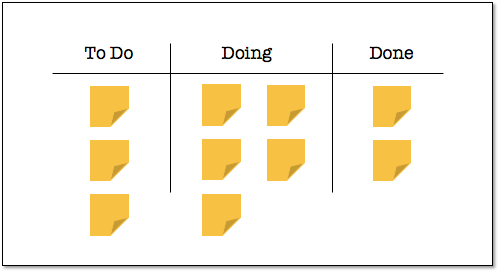
Immediately, you can get a sense of how much work is in play, how much has been completed and how much is to come.
Over time, you can then also build up a picture of the flow of work through your process and how long individual cards remain in each phase.
Armed with this information, you can then start to assess where there are inefficiencies in your process and then look at possible ways to reduce them.
To make use of Kanban, there needs to be a pre-existing business process to which it can be applied. This process could be as simple as 3-5 steps or a considerably more complicated one.
There are two relevant areas of business operations, both of which are typically very process-driven, where Gatekeeper’s customers get the most value from contract management workflows:
These kinds of processes are ideal for managing via a Kanban board as you have a contract or vendor record at the centre, which can be moved from each phase to the next as required tasks are completed.
This is why we’ve put Kanban at the heart of Gatekeeper’s Workflow Engine. We believe that by helping you visualise where each contract agreement or supplier record is within your internal process, you can better manage it through.
This is particularly relevant if you have a complex process or one that might vary depending on the department involved, the location of the business unit or perhaps the value of the contract or criticality of the supplier.
For each permutation there might be a different sequence of events, involving different people, with different Service Level Agreements (SLAs). All this can make tracking the process harder, if you don’t have the visual reference.
Using another simple, hypothetical example for a contract approval, the Kanban Board may look like this:
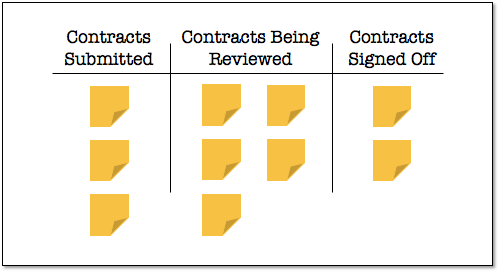
Or taking it a step further:
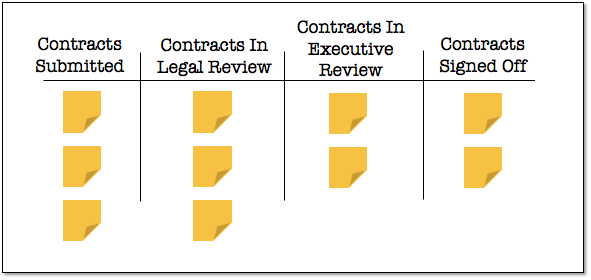
So again, you can see how you can quickly build up a helpful picture of the state of your business contracts or suppliers.
Clearly this is beneficial up to a point, but it’s actually only the start of how Gatekeeper uses Kanban to optimise your contract and vendor management.
What if you could take the manual administration out of the process, freeing up time to focus on the work that really adds value?
Where Gatekeeper is really smart, is that it links the helpful, visual process of Kanban with automation of your contract and vendor workflows, so that you can set up the processes as you want and then let them run 24/7 to keep them on track.
Gatekeeper allows for an unlimited number of users so you can invite as many of your colleagues to it as required. You can then include these colleagues in your workflows and assign relevant tasks to them automatically.
Gatekeeper’s secure messaging platform creates a user-friendly and auditable trail of activity which you can combine with agreed SLAs, so that delays can be identified and escalated where appropriate.
This reduces the admin required at each stage as relevant parties are notified directly when they are required to take an action and can complete it within Gatekeeper to trigger the next step.
You can quickly see the different phases where the contracts are currently. You then set the logic for each phase, such as who needs to approve and what criteria need to be ticked off.
Before you know it, your contracts are being funneled through the automated approval process with minimal manual intervention at each stage.
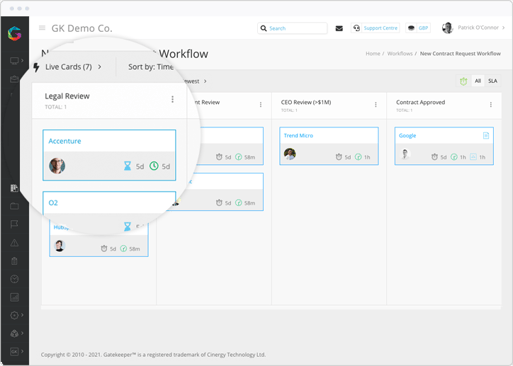 An example of a Kanban Workflow in Gatekeeper
An example of a Kanban Workflow in Gatekeeper
Creating automated workflows saves time when it comes to processes such as contract routing and approval. Teams save time from chasing teams for updates or trying to find where a contract is in its process.
Even for the most complex workflows, contract automation can create new efficiencies."
Gatekeeper's Kanban Workflow Engine allows teams to reach the most efficient path to completion, regardless of how many stakeholders are involved in the approval process. With sequential and parallel approvals, throughput is vastly improved.
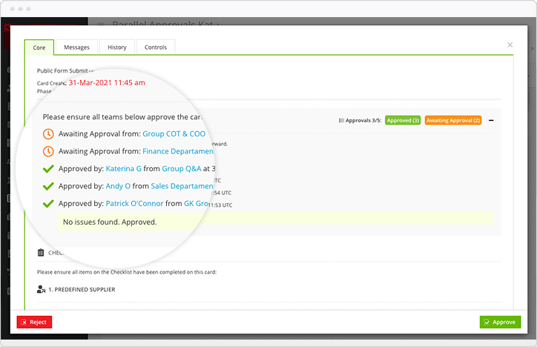 Use parallel approvals to increase throughput
Use parallel approvals to increase throughput
To help teams identify and resolve bottlenecks, Gatekeeper also offers workflow reporting. This allows teams to identify and resolve bottlenecks, so overall contracting time can be improved.
As mentioned before, if you struggle with data integrity for your contract submissions and new vendor records, then Gatekeeper provides you with an elegant solution.
By using our dedicated Employee and Vendor Portal, you push the responsibility for submitting accurate data onto your colleagues or suppliers.
First you set up the initiation forms as you need them with all the required data fields and instructions. You then share those forms publicly or via permission-based access with the relevant parties.
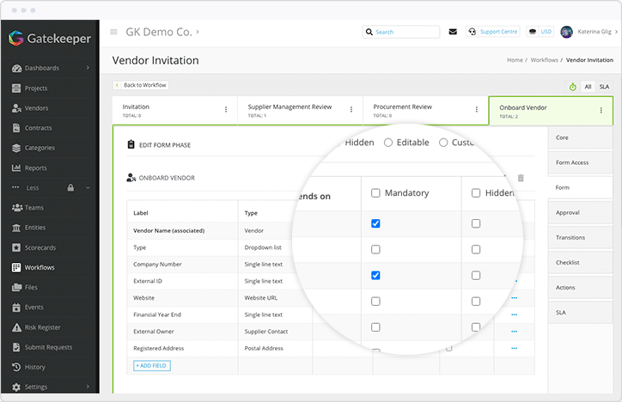 Mandate the information your vendors need to provide as part of onboarding
Mandate the information your vendors need to provide as part of onboarding
By using mandatory fields, bespoke dropdowns and links to agreed templates, you can closely control the information submitted, ensuring you get what you need each time.
Using conditional logic, you can then route new requests directly into your workflows to be managed by the relevant parties. You can design your workflows from scratch or choose one from Gatekeeper's free template library.
By doing the work up front with your forms and templates, you save massive amounts of effort further through the process as everything can then be done via automation.
And at the centre of all this is your Kanban board, showing where all your contracts and supplier records are within your processes.
At any time you can review your contract management workflow 'board' and see where you might need to direct your attention. And the more you use it, the more you can then see where the roadblocks are and whether you can improve your processes.
Using workflows to increase efficiency, accuracy and throughput throughout your organisation creates a greater level of control when it comes to managing contracts and vendors. Whether you have multiple processes that require automation or fewer processes that are slightly more complex, best-practice workflow templates can help.
Leverage workflow features without having to start from scratch. Escalate risks, manage internal requests and stay ahead of renewals with instantly configurable workflows that can be adapted to match the needs of your business.
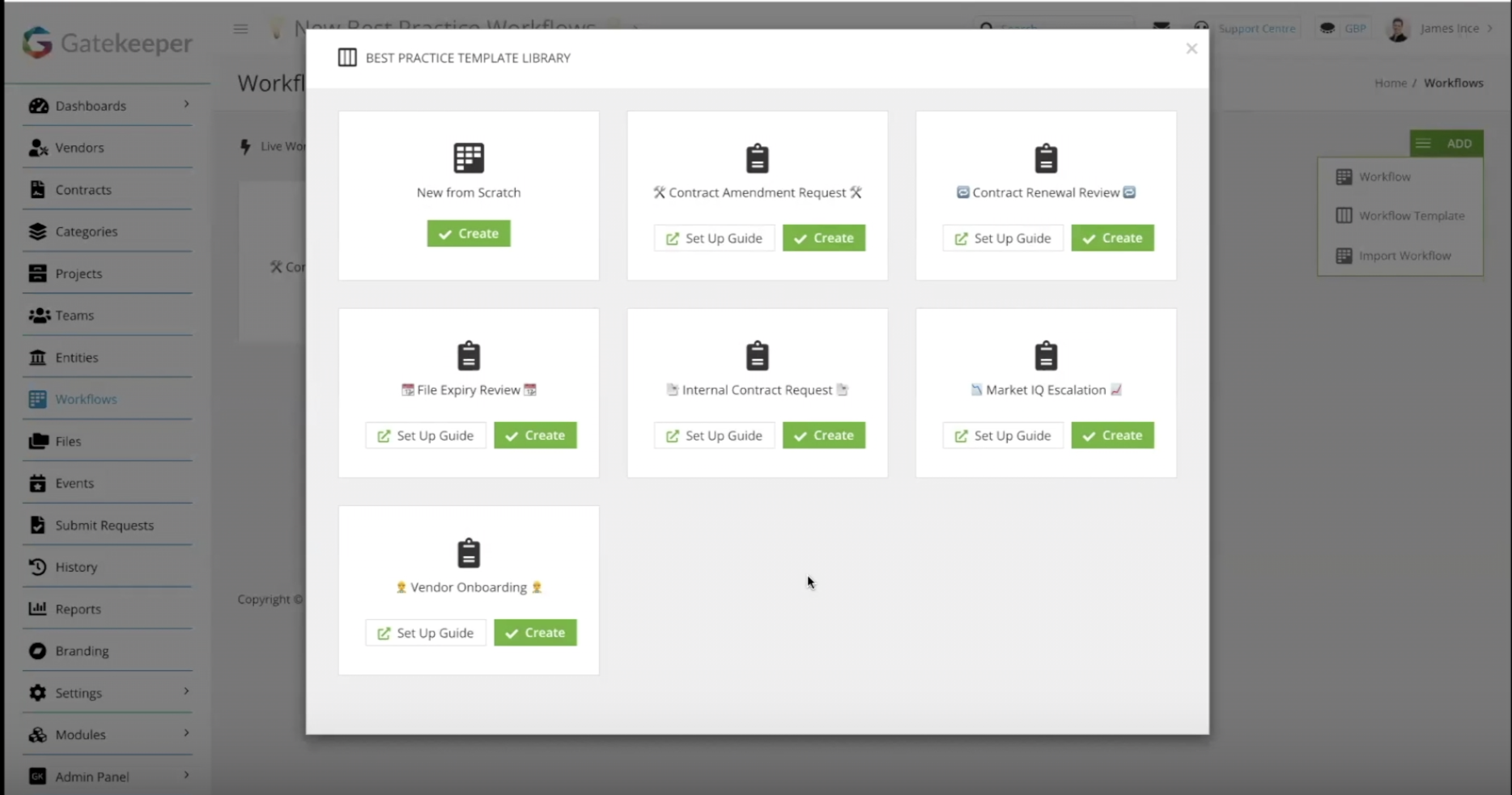 Best Practice Workflow Templates from Gatekeeper
Best Practice Workflow Templates from Gatekeeper
Access templates and set-up guides with just a few clicks so you can streamline and automate many key stages of vendor and contract lifecycle management.
If you would like to find out more about how our Workflow Engine can help you manage contracts and vendors more efficiently, then get in touch today for a demonstration.
Ready to improve your contract & vendor management?
.png)
.png)
.png)
-4.png)
Before Gatekeeper, our contracts
Anastasiia Sergeeva, Legal Operations Manager, BlaBlaCar
were everywhere and nowhere.
Gatekeeper is that friendly tap on the shoulder,
Donna Roccoforte, Paralegal, Hakkasan Group
to remind me what needs our attention.
Great System. Vetted over 25 other systems
Randall S. Wood, Associate Corporate Counsel, Cricut
and Gatekeeper rose to the top.
Thank you for requesting your demo.
Next Step - Book a Call
Please book a convenient time for a quick call to discuss your requirements.